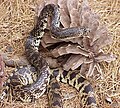| Pituophis | |
|---|---|
 | |
| Pacific gopher snake Pituophis catenifer catenifer | |
| Scientific classification | |
| Kingdom: | Animalia |
| Phylum: | Chordata |
| Class: | Reptilia |
| Order: | Squamata |
| Suborder: | Serpentes |
| Family: | Colubridae |
| Tribe: | Lampropeltini |
| Genus: | Pituophis Holbrook, 1842 |
| Synonyms | |
Churchilla, Elaphis, Epiglottophis, Pityophis, Rhinechis Contents | |
Pituophis is a genus of nonvenomous colubrid snakes, commonly referred to as gopher snakes, pine snakes, and bullsnakes, which are endemic to North America. They are often yellow or cream in color with dark spots and a dark line across their face. Some species can exceed seven feet in length. Gopher snakes can live for 15 years. The gopher snake is commonly misidentified as a rattlesnake because of its similar coloration and its defensive behavior when feeling threatened. A scared gopher snake will flatten its head, hiss loudly, and shake its tail rapidly, doing a very convincing rattlesnake imitation.




